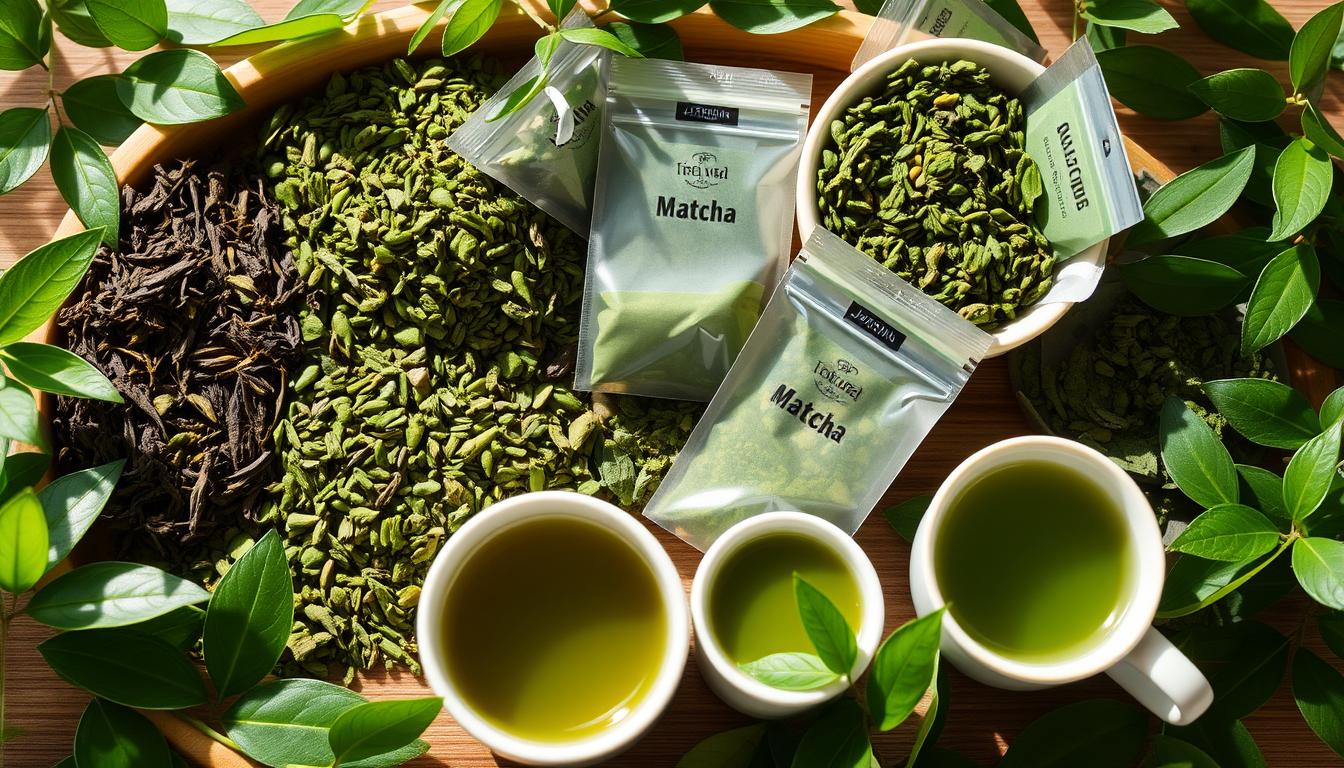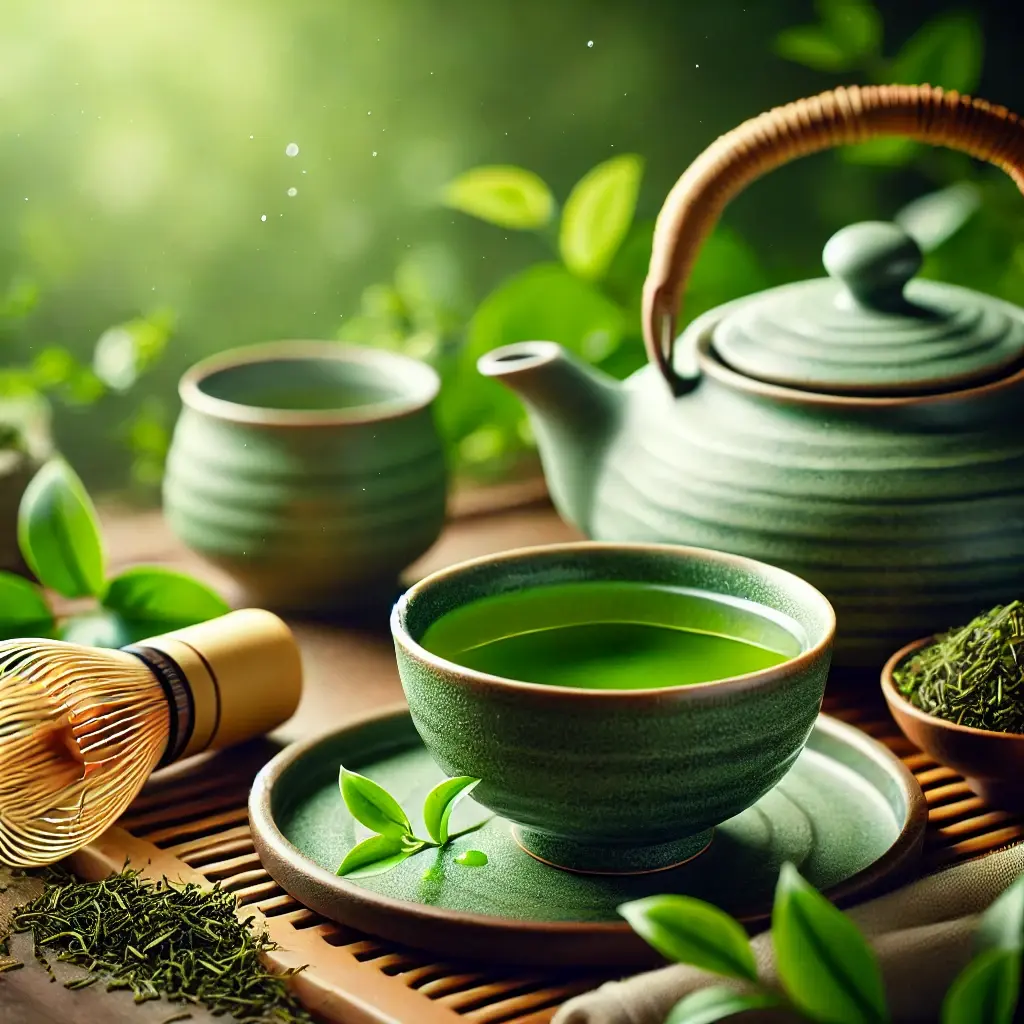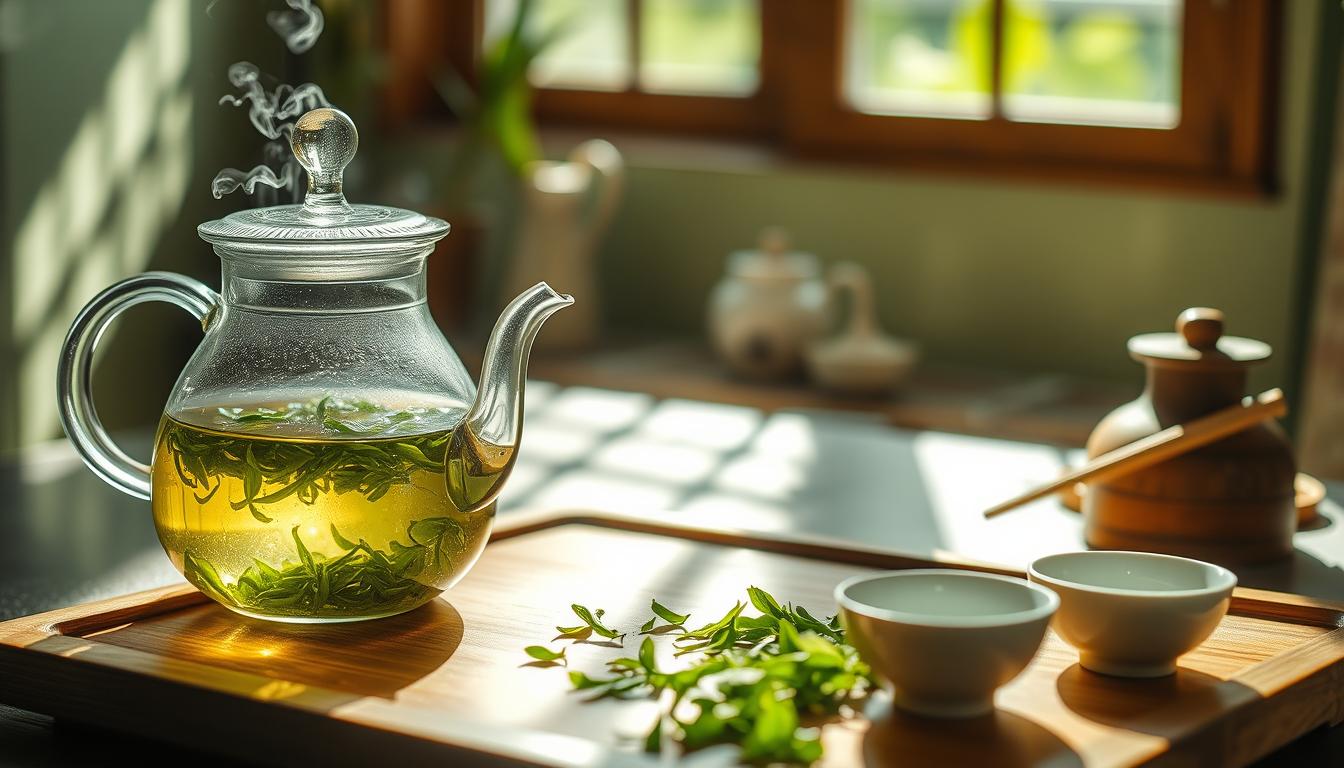What makes a perfect cup of green tea? How can you unlock its full potential to enjoy its many benefits? The journey to create an exceptional cup is both simple and complex. With the right techniques and knowledge, you can enhance your green tea experience and discover the unique qualities of each type.
Whether you’re new to tea or a seasoned enthusiast, knowing the basics of green tea brewing is key. In this guide, we’ll explore the world of green tea. We’ll look at the different types, the importance of brewing techniques, and the tools needed for a perfect cup.
Key Takeaways
- Understanding the basics of green tea brewing is crucial for a perfect cup
- Choosing the right green tea type can significantly impact the flavor and green tea benefits
- Proper green tea brewing techniques can elevate the overall green tea experience
- Investing in quality tools can make a difference in the taste and aroma of your green tea
- Experimenting with different green tea types and brewing methods can help you find your perfect cup
Choosing the Right Green Tea
Choosing the right green tea can be tough with so many options. Each type has its own flavor and strength. Whether you like matcha or sencha, there’s a green tea for everyone.
Green teas vary in strength, from delicate to robust. Green tea flavors can be grassy or floral, depending on where it’s from and how it’s made. Think about these things when picking a green tea:
- Origin: Green tea from Japan, China, or other countries may have distinct flavor profiles.
- Production method: Some green teas are pan-fried, while others are steamed, affecting the final taste.
- Caffeine content: If you’re sensitive to caffeine, opt for a green tea with lower caffeine levels.
Loose leaf or tea bags are also a consideration when choosing green tea. Loose leaf tea offers more brewing options and flavor. Tea bags are easier to use. 
Finding the best green tea for you depends on your taste preferences. By exploring different green teas, you’ll find the perfect one for you.
| Green Tea Type | Flavor Profile | Strength |
|---|---|---|
| Matcha | Grassy, umami | Robust |
| Sencha | Light, refreshing | Delicate |
| Dragonwell | Floral, slightly sweet | Moderate |
The Essential Tools for Brewing Green Tea
To brew the perfect cup of green tea, you need the right tools. Green tea accessories can greatly improve the flavor and quality of your tea. A good teapot, cups, and strainers are essential for any tea lover.
A tea infuser is a valuable tool for brewing green tea. It lets the tea leaves unfurl and release their flavors, giving a more complex taste. Plus, it makes steeping the perfect cup easy, without loose leaves getting in the way.
Water temperature control is also key. The ideal temperature for green tea is between 160°F and 170°F. A water temperature control device helps achieve this, preventing the tea from tasting bitter. By using a good device, you can always brew your green tea perfectly.
Some popular green tea accessories include:
- Teapots made from ceramic or glass materials
- Tea infusers made from stainless steel or silicone
- Water temperature control devices with precise temperature settings
Investing in these essential tools will help you brew the perfect cup of green tea. Choose high-quality accessories that fit your needs and preferences. Don’t be afraid to try different tea infusers and water temperature control devices to find your favorite combination.

| Accessories | Benefits |
|---|---|
| Tea Infuser | Allows tea leaves to unfurl and release flavors |
| Water Temperature Control Device | Ensures ideal brewing temperature for green tea |
The Importance of Water Quality
When brewing green tea, water quality is key to its taste and aroma. Good water brings out the tea’s unique flavors and nutrients. The water’s quality can make or break the green tea experience.
The water type affects the tea’s taste. Tap water with impurities can change the flavor. But, filtered or purified water can enhance the green tea’s natural taste. Suitable water types include spring, filtered, and purified water.
Common mistakes include using water that’s too hot or cold. The best temperature for green tea is between 160°F and 170°F. Water that’s too hot can make the tea bitter, while too cold makes it weak.
To get the perfect green tea, consider these factors:
- Use fresh and clean water
- Avoid tap water with impurities or minerals
- Choose the right water type, such as spring water or filtered water
- Use the ideal water temperature for brewing green tea
By following these tips and using quality water, you can improve your green tea brewing. Enjoy the perfect cup every time with the right green tea brewing techniques and water quality.
Ideal Water Temperature for Brewing Green Tea
Water temperature is key when brewing green tea. It affects the tea’s flavor. The best temperature varies by green tea type. It usually ranges from 160°F to 170°F.
Sencha green tea needs water around 160°F. Matcha green tea is best at 170°F. Knowing the right temperature is important to avoid a bitter taste.
Different Green Teas and Their Perfect Brewing Temperatures
- Sencha green tea: 160°F
- Matcha green tea: 170°F
- Dragonwell green tea: 165°F
The science behind water temperature and tea flavor is complex. The right temperature extracts the best flavors and antioxidants. Brewing at the right temperature greatly improves the tea’s taste and quality.
The Science Behind Water Temperature and Tea Flavor
Knowing the ideal water temperature lets you try different green teas. Whether you’re new to tea or a seasoned lover, mastering brewing enhances your experience.
Steeping Time: How Long Should You Brew Green Tea?
Steeping time is key when brewing green tea. It can make or break the perfect cup. The right time brings out the tea’s flavor and aroma.
The steeping time varies by tea type and personal taste. Longer times make the tea more bitter. Shorter times make it lighter and more delicate.
The Impact of Steeping Time on Flavor
Steeping time greatly affects the tea’s flavor. Longer times mean a stronger taste. But, too long can make it bitter.
The Ideal Steeping Time for Different Green Tea Varieties
Here are some general guidelines for steeping times for different green tea varieties:
- Sencha: 1-2 minutes
- Matcha: 1-2 minutes
- Dragonwell: 2-3 minutes
What Happens If You Over-Steep or Under-Steep Your Tea?
Over-steeping makes tea bitter. Under-steeping makes it weak. To avoid this, try different steeping times to find the perfect balance.
| Steeping Time | Tea Flavor |
|---|---|
| 1-2 minutes | Light, delicate |
| 2-3 minutes | Balanced, smooth |
| 3-5 minutes | Strong, intense |
Step-by-Step Guide to Brewing Green Tea
To make the perfect green tea, follow a simple guide. It includes choosing the right tea, water temperature, and steeping time. Loose leaf tea brewing takes a bit more work, but it’s worth it.
Measuring the tea is crucial. The right amount of leaves affects the tea’s taste and smell. Use one teaspoon of loose leaf tea for every eight ounces of water.
How to Brew Loose Leaf Green Tea for Maximum Flavor
Begin by heating water to the perfect temperature. The ideal range is 160-170°F, depending on the tea type. Then, add the loose leaf tea to a teapot or infuser.
The Right Amount of Tea for a Single Cup
For a single cup, the tea amount is key. Too much can make it bitter, too little weak. Start with one teaspoon of loose leaf tea for eight ounces of water.
Brewing Green Tea in a Teapot vs. a Single Cup
Teapots and single cups both work for brewing green tea. It’s a matter of personal choice. Teapots are great for big batches, while single cups are perfect for one serving. The important thing is to use the right tea leaves and water temperature.
Common Mistakes to Avoid When Brewing Green Tea
When brewing green tea, it’s easy to make mistakes. These can change the flavor and quality of the tea. One big mistake is using boiling water, which burns the tea leaves and makes it bitter. Another mistake is over-steeping the tea, which also makes it bitter and less enjoyable.
To avoid these mistakes, use the right water temperature and steeping time. The best water temperature for green tea is between 160°F and 170°F. The steeping time varies by tea type. Here are some common mistakes to avoid:
- Using boiling water, which can burn the tea leaves
- Over-steeping the tea, which can lead to a bitter flavor
- Using too much or too little tea, which can affect the flavor and quality of the tea
By avoiding these mistakes, you can enjoy a perfect cup of green tea every time. Remember to use the right water temperature, steeping time, and amount of tea. This will bring out the best flavor and quality of your green tea.
| Mistake | Effect on Tea |
|---|---|
| Using boiling water | Bitter flavor |
| Over-steeping | Bitter flavor |
| Using too much or too little tea | Affects flavor and quality |
How to Enjoy Green Tea
Green tea is a tasty and healthy drink you can have any time. To get the most green tea benefits, know when to drink it and what to eat with it. It’s great for energy or to unwind.
There are many ways to enjoy green tea pairing. It goes well with sweet things like cakes and savory foods like sushi. Try it with fruits or nuts for a special taste.
To make your green tea taste better without losing its health perks, use natural sweeteners like honey or stevia. Adding fresh lemon juice or a citrus slice can also refresh it. Here are some tips:
- Drink green tea in the morning to boost your energy and metabolism
- Pair green tea with a healthy snack, like fruits or nuts, for a satisfying treat
- Experiment with different sweeteners and flavorings to find your perfect cup
By following these tips, you can enjoy green tea’s benefits and its unique taste. So, brew a cup and discover the joy of green tea.
| Green Tea Type | Best Pairing | Sweetener |
|---|---|---|
| Sencha | Sushi | Honey |
| Matcha | Fruits | Stevia |
| Dragonwell | Nuts | Lemon juice |
Advanced Green Tea Brewing Tips
Want to level up your green tea brewing? There are advanced techniques to explore. These methods help you create unique and tasty green tea blends. You can impress even the most picky tea lovers.
One key tip is to experiment with brewing times and temperatures. This brings out the best flavor and aroma in your tea.
Reusing green tea leaves is another great tip. It saves money and reduces waste. Also, try cold brewed green tea for a smoother taste. Mixing green tea with herbal tea or spices like mint or lemon can also enhance the flavor.
Here are some advanced green tea brewing tips:
- Reuse green tea leaves for multiple brews to reduce waste and save money
- Experiment with cold brewed green tea for a smoother flavor
- Combine green tea with herbal tea or other herbs and spices for unique flavors
By using these advanced green tea brewing tips, you can make your tea more flavorful. Whether you like cold brewed green tea or hot brew, there are many ways to improve your tea’s taste. So, why not try something new today and find your perfect green tea?
| Green Tea Type | Brewing Time | Temperature |
|---|---|---|
| Sencha | 1-2 minutes | 160-170°F |
| Matcha | 1-2 minutes | 160-170°F |
| Cold Brew | 2-4 hours | Room temperature |
Conclusion
As we wrap up our guide on brewing the perfect green tea, remember that personalization is key. This guide has given you the basics, but the real fun is in finding your own way. Try different teas, water temperatures, and steeping times to find what you love.
Final Tips for Brewing the Perfect Cup Every Time
Here are some final tips to make sure you always get the perfect green tea: use high-quality loose leaf tea, the right water temperature, and watch the steeping time. Get a good tea infuser or filter to bring out more flavor. Don’t be shy to try cold brewing or adding herbs and spices.
The Importance of Personalizing Your Green Tea Experience
The real joy of green tea is in the journey of discovery. By making your brewing process your own, you’ll not only make the perfect cup but also appreciate it more. Enjoy the ritual, savor the taste, and let green tea be a big part of your wellness routine.

